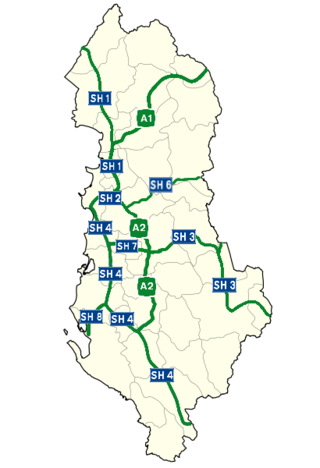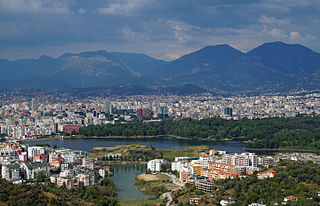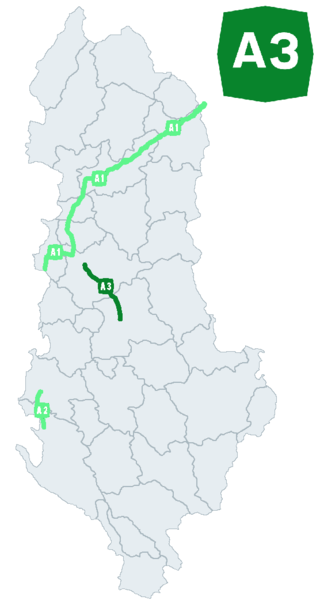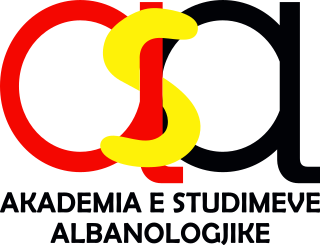
Tirana is the capital and largest city of Albania. It is located in the centre of the country, enclosed by mountains and hills with Dajti rising to the east and a slight valley to the northwest overlooking the Adriatic Sea in the distance. Due to its location at the Plain of Tirana and the close proximity to the Mediterranean Sea, the city is particularly influenced by a Mediterranean seasonal climate. It is among the wettest and sunniest cities in Europe, with 2,544 hours of sun per year.

Transport in Albania consists of transport by land, water and air, which are predominantly under the supervision of the Ministry of Infrastructure of Albania. The development and improvement of the transport in the country remains among the most important priorities of the Government of Albania.

Edi Rama is an Albanian politician, painter, writer, former university lecturer, publicist and former basketball player, who has served as the 33rd and current Prime Minister of Albania since 2013 and chairman of the Socialist Party of Albania since 2005. Prior to his tenure as Prime Minister, Rama held a number of positions. He was appointed Minister of Culture, Youth and Sports in 1998, an office he held until 2000. First elected mayor of Tirana in 2000, he was reelected in 2003 and 2007.

The Albania national football team represents Albania in men's international football, and is governed by the Albanian Football Association, the governing body for football in Albania.

The Qemal Stafa Stadium, named after Qemal Stafa (1920–1942), a World War II hero, was a national stadium and the largest football stadium in Tirana, Albania. Construction started in 1939 and the stadium was inaugurated in 1946 for the Balkan Cup, which was won by the Albania national football team. The stadium has been used for football matches of the Albanian Superliga and the national team, athletic events, and the six Albanian Spartakiads. Although it was enlarged in 1974 to accommodate up to 35,000 spectators, in the 1990s it became an all-seater stadium, and its capacity was reduced to 19,700.

Qemal Stafa was a founding member of the Albanian Communist Party, and the leader of its youth section.
Kashar is a village and a former municipality in the Tirana County, central Albania. The population at the 2011 census was 43,353.

The Skanderbeg Square is the main plaza in the centre of Tirana, Albania. The square is named after the Albanian national hero Gjergj Kastrioti Skënderbeu. The total area is about 40,000 square metres. The Skanderbeg Monument dominates the square.

The Grand Park of Tirana, or the Park on the Artificial Lake, is a 289 hectare public park situated on the southern part of Tirana, Albania, and administered by the Agency of Parks and Recreation of the Municipality of Tirana.

The Pyramid of Tirana is a structure and former museum located in Tirana, the capital of Albania. It opened as a museum in 1988 and became a conference center in 1991 following the collapse of Communism. During the 1999 Kosovo War, the building was used as a NATO base. In 2018, a new project was unveiled that would turn the pyramid into a youth IT center for Creative Technologies with a focus on computer programming, robotics, and start ups under the name of TUMO Center Tirana. The renovated structure was opened to the public in May 2023.

The A3 motorway is a motorway in Albania spanning 31.17 kilometres across the counties of Elbasan and Tirana. It consists of two traffic lanes and an emergency lane in each driving direction, except in tunnels where there are emergency bays instead, separated by a central reservation.

Tirana Logistic Park (TLP) offers logistic services in Albania. Tirana Logistic Park is a project of 3 "Class A" warehouses and industrial premises in the biggest industrial area of Albania, along the Tirana-Durrës highway. It is the first logistic park in Albania intended to help this country to attract more foreign investment. With its 80,000 square metres (860,000 sq ft) of buildings on 200,000 square metres (2,200,000 sq ft) of land, TLP is the first logistic and industrial Park in Albania, able to meet European standards in storage and manufacturing that combine different logistic modes and solutions. It is one of the most important investments in Albania and one of the biggest logistic parks in South East Europe. This logistic park was open on October this year.

The University of Medicine, Tirana (UMT) is a public university of Health and Medical Sciences located in Tirana, Albania.

The Academy of Albanological Studies is the main institution of albanology in Albania.

The Central State Film Archive is the main film archive of Albania. Based in Tirana, the archive has listed in its repository 271 feature films, 166 animated films, 1,131 documentaries and 1,012 film chronicles between the years 1945–2015.

Arena Kombëtare is an all-seater, multi-purpose football stadium located in the capital city of Tirana which was built on the ground of the former Qemal Stafa Stadium. The stadium has a seating capacity of 22,500 constituting the largest stadium in Albania.

Piro Qirjo is an Albanian actor and director. Most notably, he played Gjorg Berisha in Të paftuarit of Ismail Kadare's adaptation of Broken April and the German Wehrmacht major Max in Kronikë e një nate. His directing career is known for documentary films and various advertisement films.

The motorways in Albania are the controlled-access highway system in Albania predominantly under the supervision of the Ministry of Infrastructure and Energy. The motorways are characterised as roads with at least two lanes in each driving direction including an emergency lane and a maximum allowed speed limit of not less than 110 kilometres per hour (68 mph).

The history of photography in Albania begins with the Marubi Dynasty and its founder Pietro Marubi (1834–1903), who settled in the northwestern city of Shkodër from Piacenza, Italy during the second half of the nineteenth century and opened the first photography studio there in 1858. Having no children of his own, Marubi's first assistants and faithful successors were Mati and Kel Kodheli, the sons of his gardener Rrok Kodheli. Pietro sent Mati, the elder of the two brothers, to study photography at the Sebastianutti & Benque studio in Trieste. When Mati died prematurely at age nineteen, in 1881, Pietro adopted Kel, whom he also sent to Italy to study and who would later assume the surname Marubi. Upon Pietro's death in 1903, Kel inherited his adopted father's studio and continued its work. He, in turn, was followed into business by his own son, Geg Marubi, who studied photography and cinematography in France at the Lumière brothers’ studio.



















